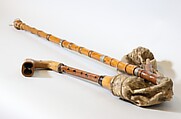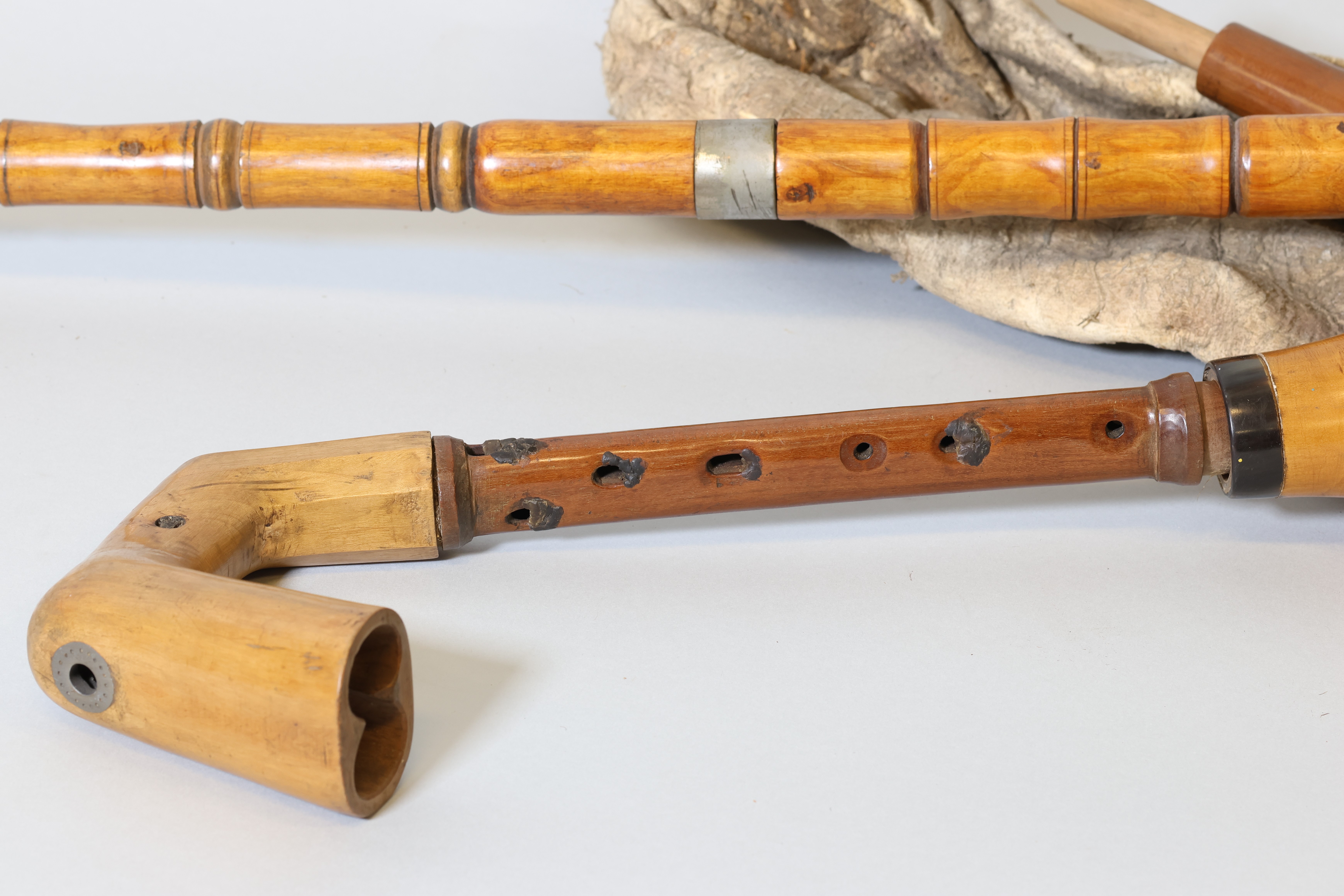Gajde
Not on view
The gajde is a double bored bagpipe that was historically widespread in North-Western Croatia (Slavonia, Srijem) and Northern Serbia (Vajvodini), gradually spreading to Southern Serbia at the beginning of the 20th century. Pipers were well-respected and played at weddings and celebrations. Some also played at communal village events, such as harvests, to encourage people during their work. Gajde players often sang and played at the same time. While most gajde players used mouth-blown instruments, some attached their bagpipe to bellows to enable them to sing more easily. However, most pipers played the mouth-blown instruments, some using this as a strategy to avoid having to sing too much (Širola 1937:242). While gajde players were common in Slavonia, Srijem and Northern Serbia, their numbers had already started to decline in the 1930s.
This gajde comes from the village of Stari Andrijevci in Slavonia (North Western Croatia). Bagpipes were often made by the bagpipers themselves. In his monograph on Croatian wind instruments,music ethnograher Božidar Širola records meeting Adam Ćipuzović, a bagpiper and bagpipe maker from Andrijevci born in 1887 who had made five or six bagpipes for himself, and who would occasionally sell the ones he was not using for 10 forints (Širola 1937:180), silver coins used in Croatia during the Austrian Empire.
The bag of this gajde is made out of goat. Goat was considered superior to sheepskin as it was more airtight. Following traditional practice, the bagpipe is made out of different woods. Each village had its particularities; in Andrijevci, the chanter was made out of plum wood (preferred for its density), the horn was made out of maple or hickory, and the drone was usually made out of plum vine. The joints of the drone were strengthened with pewter rings (see Širola 1937:216-17 for more detail). The drone features a small end plug that could silence it, which was mainly used when the piper tuned his instrument. Wax was used to tune the instrument, and was always at hand, stored on the double chanter. This instrument makes good use of wax with almost every fingerhole adjusted to obtain the desired tuning. The end of the melodic bore (right; 5 finger holes and no thumbhole) is plugged with wax. The length of the bore is defined by a hole on the side of the chanter, adjusted with wax. The drone bore (left) has one finger hole at the lower end of the chanter, activated by the sixth finger, enabling two different tones. The bore is drilled through and the tuning is adjusted with wax around the hole. The single reeds are inserted deep into the top of the double chanter, protected by the wooden encasing.
The wooden horn at the end of the double chanter, made out of a lighter wood than the chanter, was gouged out with a knife. Two side holes on the central and lower part of the horn have been covered with wax. A third hole, at the base of the raised opening, is encircled with pewter. This hole was used to evacuate condensation that had accumulated at the base of the horn – pipers could play for days at a time for celebrations such as weddings, and this would have been a useful feature. Bagpipe-maker Adam Ćipuzović explained to Širola in the 1930s that he would merge the two horn openings instead of keeping the partition closed as might be found on gajdes from other villages: ‘this is where the delighted wedding guests and dancers will insert their gifts into the gajde. That’s why the partition had to be broken … so that a forint [silver coin] could be pushed into the horn’ (Ćipuzović quoted in Širola 1937:241).
This instrument was formerly owned by Božidar Širola (1889 - 1956). Širola was a specialist of Croatian music in the first half of the twentieth century. He was a composer, the curator and director of the Ethnographic Museum, the dean of the Music Academy of Zagreb, and a high school teacher (Brožek 1957). The instrument was part of the New York Public Library collection until 1976, when it was exchanged along with forty-two other instruments and six accompanying items for a collection of sheet music and music books held at the Metropolitan Museum.
(Cassandre Balosso-Bardin, 2023)
Technical description
Chanters (dual bore in 1 block) 316 mm R 5/1, L 1/0, right chanter stopped with wax above bell, only left pipe communicating with bell; bell with 3 ventholes, 2 of which are stopped;
2 single reeds of elder (jammed in reed seats);
1 bass drone in 3 sections 935 mm, single downcut reed of elder with open end cut diagonally;
2-piece blowpipe protruding 124 mm, with leather flap valve (missing); rough kidskin bag;
Drone mounted with nickel-silver, chanter stock with horn band.
References
Brožek, Josef, 1957. Božidar Širola. Journal of the International Folk Music Council, 9, 77-77.
Širola, Božidar, 1937. Sviraljke sudarnim jezičkom. Zagreb: tisak nadbiskupske tiskare.
Due to rights restrictions, this image cannot be enlarged, viewed at full screen, or downloaded.
This artwork is meant to be viewed from right to left. Scroll left to view more.





